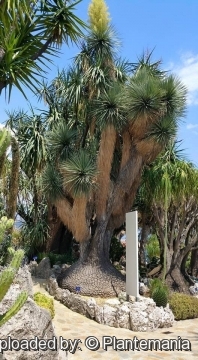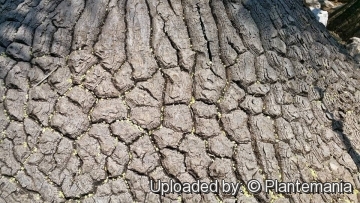Accepted Scientific Name: Beaucarnea stricta Lem.
Ill. Hort. Misc.: 59 1861

Beaucarnea recurvata var. stricta (Beaucarnea stricta) Photo by: © Plantemania
Growing habitat at le jardin exotique de Monaco
Origin and Habitat: Central Mexico (Guerrero, Puebla and Oaxaca )
Habitat: It grows in dry tropical deciduous forest on steep hillsides, along with massive columnar cacti and cycads.
Synonyms:
See all synonyms of Beaucarnea stricta
back
Accepted name in llifle Database:Beaucarnea stricta Lem.Ill. Hort. Misc.: 59 1861Synonymy: 7
back
Common Names include:
ENGLISH: Bottle Palm, Beargrass
SPANISH (Español): Estrellas
Description: Beaucarnea strictaSN|20517]]SN|22884]] is an arborescent plant, slightly branching at top, that develops a curious, massive caudex textured like a tortoise's shell. It is not nearly as popular in nurseries as its cousins Beaucarnea hartwegiana and Beaucarnea recurvataSN|22884]]SN|20517]]. The primary difference is in the leaves straight, erect on the crown instead of curving and much stiffer.
Stem (succulent caudex and trunk): Bulbously thickened at base with a slender trunk somewhat branching above, but usually not branching before it reaches quite some height. Total height 4-8(-10) m, the base will slowly reach 3 m in diameter. The trunk and branches are clothed for quite a time with the remains of many dried leaves.
Rosettes: Dense crowded at the stems apex.
Leaves: Pale greyish-green to glaucous-blue, straight, stiff, rigid, channelled, keeled, spreading, later extended or dropping, 60-90 cm long, (8-)9-12(-15) cm wide and many remain erect in the crown of the plant, base not quite as bulbous as the other species, surface with papillose groves, margin minutely rough.
Inflorescence: Egg-shaped 60 to 80 cm tall, with 20 to 30 cm wide. Inflorescence stalk bearing many irregularly arranged flowering branches almost to the base.
Flowers: Cream coloured, perianth about 1,5 mm broad.
Fruit: Elliptical capsule, 6-10 mm long, up to 6-12 mm wide and contain one seed.
Seed: Irregularly triangular 3-4,5 mm broad.
Bibliography: Major references and further lectures
1) Sean Hogan, “Flora: a gardener's encyclopedia” Volume 1 Timber Press (Portland, Or.) 2003
2) James Cullen, Sabina G. Knees, H. Suzanne Cubey “The European Garden Flora Flowering Plants: A Manual for the Identification of Plants Cultivated in Europe, Both Out-of-Doors and Under Glass” Cambridge University Press, 11/ago/2011
3) Yvonne Cave “Succulents for the contemporary garden” Timber Press, 01/gen/2003
4) “The New Plantsman” Royal Horticultural Society, 1998
 Nolina stricta. Caudex at le jardin exotique de Monaco (Beaucarnea stricta) Photo by: © Plantemania
Nolina stricta. Caudex at le jardin exotique de Monaco (Beaucarnea stricta) Photo by: © Plantemania Nolina stricta. Tree-like habitat at le jardin exotique de Monaco (Beaucarnea stricta) Photo by: © Plantemania
Nolina stricta. Tree-like habitat at le jardin exotique de Monaco (Beaucarnea stricta) Photo by: © Plantemania Beaucarnea recurvata var. stricta (Beaucarnea stricta) Photo by: © Plantemania
Beaucarnea recurvata var. stricta (Beaucarnea stricta) Photo by: © PlantemaniaSend a photo of this plant.The gallery now contains thousands of pictures, however it is possible to do even more. We are, of course, seeking photos of species not yet shown in the gallery but not only that, we are also looking for better pictures than those already present.
Read More... Cultivation and Propagation: It is a very tolerant plant that can withstand temperatures of -5 Celsius degrees for short periods, but its exact hardiness is unknown. Because of its extreme drought tolerance, it makes a great container plant for light shade to full sun, or is an excellent foliage accent in a dry garden in warm regions. Might look its best in a vase shaped terra cotta pot to allow the leaves to drape downwards. It needs moderate water when actively growing, little water the rest of the time, if established. Outdoor it needs heavy soil with excellent drainage and circulating dry air. It is a tough plant. Having been bred to endure dry air and drought, it will survive for years in less than ideal conditions. It can stay in the same pot for a number of years since it prefers to be a bit rootbound.
Propagation: Seeds; stem cuttings. (it cannot be reproduced by leaves cuttings).












